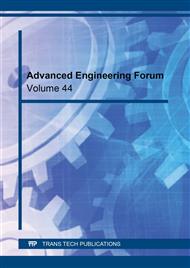[1]
R. S. Pereira. Recuperação estrutural de vigas de concreto armado colapsadas utilizando reforço de fibra de carbono, (2016). 27 f. Artigo (Graduação em Engenharia Civil) – Universidade do Extremo Sul Catarinense, Criciúma.
DOI: 10.17771/pucrio.acad.6958
Google Scholar
[2]
C. Xiong, Q. Li, T. Lan, H. Li, W. Long, F. Xing, Sustainable use of recycled carbon fiber reinforced polymer and crumb rubber in concrete: mechanical properties and ecological evaluation, Vol. 279 (2021), pp.1-14.
DOI: 10.1016/j.jclepro.2020.123624
Google Scholar
[3]
D.D.L. Chung. Cement reinforced with short carbon fibers: a multifunctional material, Composites: B 31, Vol. 6 (2000), p.511–526.
DOI: 10.1016/s1359-8368(99)00071-2
Google Scholar
[4]
P. Garcés, J. Fraile, E. Vilaplana-Ortego, D. Cazorla-Amorós, E.G. Alcocel, L.G. Andión, Effect of carbon fibres on the mechanical properties and corrosion levels of reinforced portland cement mortars, Cem. Concr. Res. Vol.35 (2) (2005), p.324–331.
DOI: 10.1016/j.cemconres.2004.05.013
Google Scholar
[5]
F. Reza, J. A. Yamamuro, G. B. Batson. Electrical resistance change in compact tension specimens of carbon fiber cement composites, Cem. Concr. Compos. Vol 26 (7) (2004), p.873–881.
DOI: 10.1016/j.cemconcomp.2003.06.002
Google Scholar
[6]
V. C. Li, K. Hobla, Effect of fiber length variation on tensile properties of carbon fiber cement composite, Compos. Eng. Vol. 4 (9) (1994), p.947–964.
DOI: 10.1016/0961-9526(94)90037-x
Google Scholar
[7]
D-M. Bontea, D.D.L. Chung, G.C. Lee. Damage in carbon fiber-reinforced concrete, monitored by electrical resistance measurement, Cem. Concr. Res. Vol. 30 (4) (2000), p.651–659.
DOI: 10.1016/s0008-8846(00)00204-0
Google Scholar
[8]
C. Wang, K.-Z. Li, H.-J. Li, G.-S. Jiao, J. Lu, D.-S. Hou. Effect of carbon fiber dispersion on the mechanical properties of carbon fiber-reinforced cement-based composites, Mater. Sci. Eng: A 487. Vol. (1–2) (2008), p.52–57.
DOI: 10.1016/j.msea.2007.09.073
Google Scholar
[9]
Z. Bayasi, J. Zeng. Properties of polypropylene fiber reinforced concrete, Am. Concr. Inst. J. 90 Vol. (6) (1993), p.605–610.
Google Scholar
[10]
D. Foti, On the numerical and experimental strengthening assessment of tufa masonry with FRP, Mech. Adv. Mater. Struct. Vol. 20 (2) (2013), p.163–175.
DOI: 10.1080/15376494.2012.743634
Google Scholar
[11]
D. Foti, S. Vacca, Comportamiento mecánico de columnas de hormigón armadoreforzadas con mortero reoplástico/Mechanical behavior of concrete columns reinforced with rheoplastic mortar, Materiales De Construcción. Vol. 63 (310) (2013), p.267–282.
DOI: 10.3989/mc.2012.03512
Google Scholar
[12]
FIB bulletin n. 40, 'FRP reinforcement in RC structures, has been added, (2007).
Google Scholar
[13]
D. Foti, Preliminary analysis of concrete reinforced with waste bottles PET fibers, Constr. Build. Mater. Vol. 25 (2011), p.1906–1915.
DOI: 10.1016/j.conbuildmat.2010.11.066
Google Scholar
[14]
M.S. Meddah, M. Bencheikh, Properties of concrete reinforced with different kinds of industrial waste fibre materials, Constr. Build. Mater. 23 (10) (2009) 3196–3205.
DOI: 10.1016/j.conbuildmat.2009.06.017
Google Scholar
[15]
D. Foti, Use of recycled waste pet bottles fibers for the reinforcement ofconcrete, Compos. Struct. Vol. 96 (2013), p.396–404.
DOI: 10.1016/j.compstruct.2012.09.019
Google Scholar
[16]
F. Fraternali, I. Farina, C. Polzone, E. Pagliuca, L. Feo, On the use of R-PET strips for the reinforcement of cement mortars, Composites Part B: Eng. Vol. 46 (2013), p.207–210.
DOI: 10.1016/j.compositesb.2012.09.070
Google Scholar
[17]
R. Siddique, J. Khatib, I. Kaur. Use of recycled plastic in concrete: A review, Waste Manage. Vol. 28 (2008), p.1835–1852.
DOI: 10.1016/j.wasman.2007.09.011
Google Scholar
[18]
L.P. Pereora de Oliveira, J.P. Castro-Gomez, Physical and mechanical behaviour of recycled PET fibre reinforced mortar, Constr. Build. Mater. Vol. 25 (2011), p.1712– 1717.
DOI: 10.1016/j.conbuildmat.2010.11.044
Google Scholar
[19]
E. Rahmani, M. Dehestani, M.H.A. Beygi, H. Allahyari, I.M. Nikbin, On the mechanical properties of concrete containing waste PET particles, Constr. Build. Mater. Vol. 47 (2013), p.1302–1308.
DOI: 10.1016/j.conbuildmat.2013.06.041
Google Scholar
[20]
L. Ávila Córdoba, G. Martínez-Barrera, C. Barrera Díaz, F. Ureña Nuñez, A. Loza Yañez, Effects on mechanical properties of recycled PET in cement-based composites, Int. J. Polym. Sci. (2013), p.1–6.
DOI: 10.1155/2013/763276
Google Scholar
[21]
T. Ochi, S. Okubo, K. Fukui, Development of recycled PET fiber and its application as concrete-reinforcing fiber, Cem. Concr. Compos. Vol. 29 (2007), p.448–455.
DOI: 10.1016/j.cemconcomp.2007.02.002
Google Scholar
[22]
S.B. Kim, N.H. Yi, H.Y. Kim, J.H.J. Kim, Y.-C. Song, Material and structural performance evaluation of recycled PET fiber reinforced concrete, Cem. Concr. Compos. Vol. 32 (2010), p.232–240.
DOI: 10.1016/j.cemconcomp.2009.11.002
Google Scholar
[23]
S. Chowdhury, A.T. Maniar, O. Suganya, Polyethylene terephthalate (PET) waste as building solution, Int. J. Chem. Environ. Biol. Sci. 1 (2013), p.2320–4087.
Google Scholar
[24]
L.A. Cordoba, G.M. Berrera, C.B. Diaz, F.U. Nunez, A.L. Yanez, Effects on mechanical properties of recycled PET in cement-based composites, Int. J. Polym. Sci. (2013), p.1–6.
Google Scholar
[25]
P. Neto, J. Alfaiate, J. Vinagre, A three-dimensional analysis of CFRP–concrete bond behavior, Composites Part B: Eng. Vol. 59 (2014), p.153–165.
DOI: 10.1016/j.compositesb.2013.11.025
Google Scholar
[26]
I. Nishizaki, Y. Kato, Durability of the adhesive bond between continuous fibre sheet reinforcements and concrete in an outdoor environment, Constr. Build. Mater. Vol. 25 (2011), p.515–522.
DOI: 10.1016/j.conbuildmat.2010.04.067
Google Scholar
[27]
X. Wang, W. Zhang, W. Cui, F.H. Wittmann, Bond strength of corroded steel bars in reinforced concrete structural elements strengthened with CFRP sheets, Cem. Concr. Compos. Vol. 33 (2011), p.513–519.
DOI: 10.1016/j.cemconcomp.2011.02.008
Google Scholar
[28]
J. Xie, R. Hub, Experimental study on rehabilitation of corrosion-damaged reinforced concrete beams with carbon fiber reinforced polymer, Constr. Build. Mater. Vol. 38 (2012), p.708–716.
DOI: 10.1016/j.conbuildmat.2012.09.023
Google Scholar
[29]
M. R. Garcez. Alternativas para Melhoria no Desempenho de Estruturas de Concreto Armado Reforçadas pela Colagem de Polímeros Reforçados com Fibras. 2007. 241p. Tese (Doutorado em Engenharia Civil) – Universidade Federal do Rio Grande do Sul. Porto Alegre, RS, (2007).
DOI: 10.29381/0103-8559/2020300182-6
Google Scholar
[30]
V. Mechtcherinea, A. Michela, M. Liebschera, K. Schneidera, C. Großmann, Mineral-impregnated carbon fiber composites as novel reinforcement for concrete construction: Material and automation perspectives. Vol. 110 (2020), pp.1-8.
DOI: 10.1016/j.autcon.2019.103002
Google Scholar
[31]
P. J. Lange; P. G. Akker; E. Mader; S. L. Gao; W. Prasithphol; R. J. Young, Controlled Interfacial Adhesion of Twaron© Aramida Fibers in Composites by finish formulation. Composites Science and Technology. Vol 67, pp.2027-2035, 2007.
DOI: 10.1016/j.compscitech.2006.11.018
Google Scholar
[32]
F. Zhao; Y. Huang, Improved interfacial properties of carbon fiber/epoxy composites through grafiting polyhedral oligomeric slisesquioxane on carbon fiber surface. Materials Letters. Vol. 64, pp.2742-2744, 2010.
DOI: 10.1016/j.matlet.2010.08.074
Google Scholar


